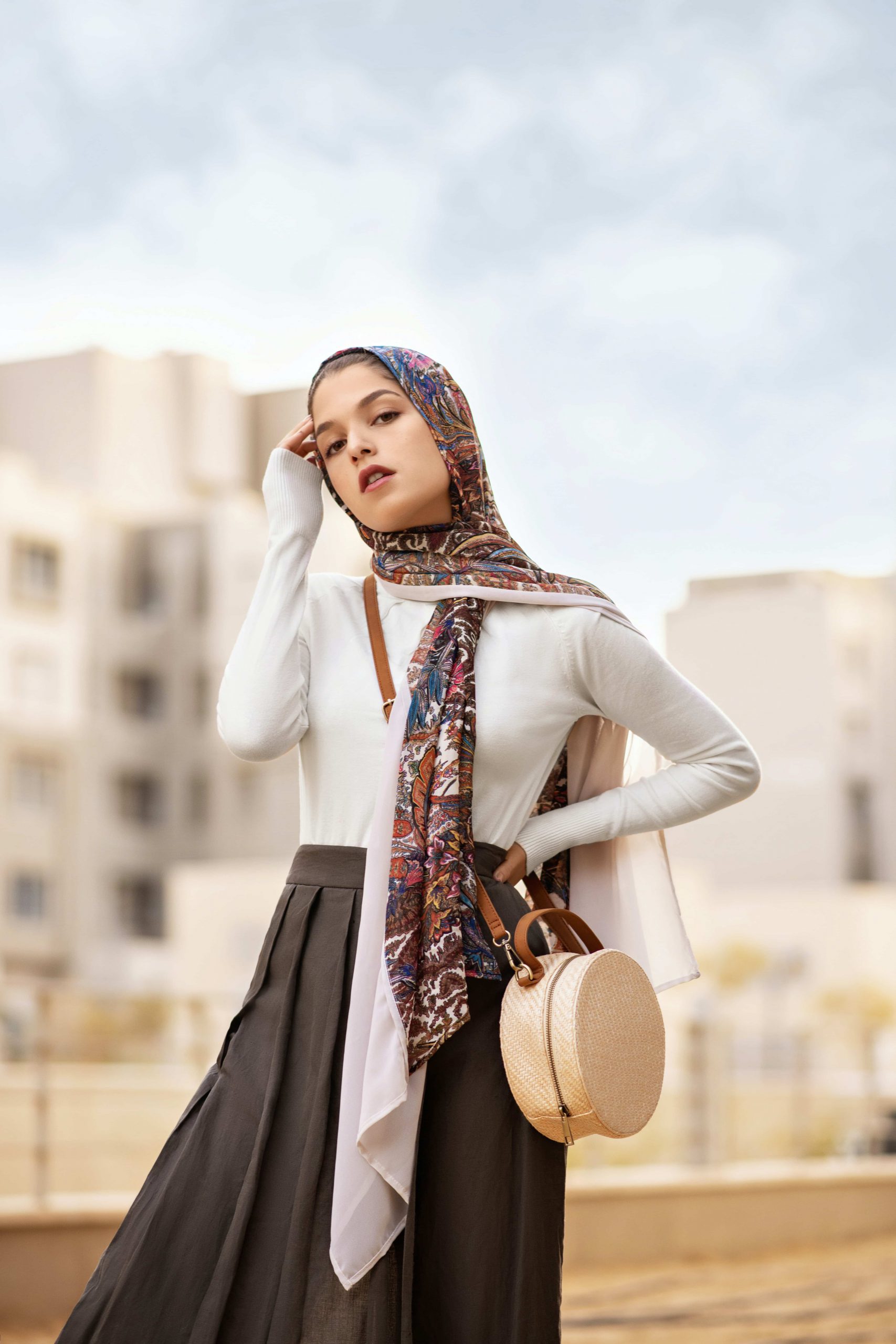So many traditional Christian women (both Orthodox and non-Orthodox) struggle with dressing modestly. Secular society makes it incredibly difficult to find clothing that does not reveal midriffs, bosoms, rear ends, and upper thighs. Rest assured, ladies, there is a way to dress modestly as a Christian woman, without coming across as rigid or looking “like a grandma”.
While modesty is often a topic almost exclusively reserved for women, men are also called to this same standard. So next week, our post will address modesty when it comes to Christian men.
Estimated reading time: 9 minutes
Table of contents
Why is what we choose to wear so important?
St. Paul tells us that our bodies are God’s temples (1 Cor 3:16; John 14:23). Since our bodies therefore belong to God and not to us, we should dress according to the Lord’s standards, not our own (and certainly not society’s). The way we dress should honor God, not dishonor Him.
In adhering to God’s standards for modesty, we become faithful witnesses of Christ, manifesting the Lord to those we interact with throughout our day. In trying to be more like Christ, we also strive not to be a stumbling block to those around us (Mark 9:42; 1 Cor 8:13; 1 Cor 8:9). As faithful Christian women (and men), we should always be mindful of our brothers and sisters, striving always to show them Jesus Christ whenever they look at us. Yes, we have the freedom to dress however we like. But if we choose to dress in an immodest manner, we unnecessarily tempt our brother or sister to sin, which is the exact opposite of manifesting Christ!
The Biblical standard for modesty
The most well-known Scriptural passage pertaining to modesty, particularly for women, is 1 Timothy 2:9-10:
in like manner also, that the women adorn themselves in modest apparel, with propriety and moderation, not with braided hair or gold or pearls or costly clothing, but, which is proper for women professing godliness, with good works.
1 Timothy is a personal and pastoral letter addressed specifically to St. Timothy, the bishop of Ephesus. In Ephesus, some church members were promoting a variety of theological opinions. The Church was also dealing with external pressures of Hellenistic piety. Thus, Saint Paul calls Timothy to a life of faithfulness, and he describes what that looks like, for both men and for women.
Women should not dress in opulent clothing that reveals parts of the body meant only for the husband. Nor should they wear excessive gold jewelry or don extravagant hairstyles. Rather, women should dress in a way that reflects faithfulness in and love for Christ – clothing that is respectable and modest, demonstrating self-control (Romans 13:13; Galatians 5:23), as this is the standard for all Christian conduct.
What is considered modest, then?
In a homily on St. Paul’s first epistle to Timothy, St. John Chrysostom paints an articulate picture of what modest truly means here:
‘That women adorn themselves in modest apparel.’ But what is this modest apparel? Such attire as covers them completely and decently, not with superfluous ornaments, for the one is becoming, the other is not […] Do you approach God to pray with braided hair and ornaments of gold? Are you coming to a dance, to a marriage, to a merry procession? […] You have come to pray, to supplicate for pardon of your sins, to plead for your offenses, beseeching the Lord, and hoping to render him propitious to you […] For is it not acting to pour forth tears from a soul overgrown with extravagance and ambition? Away with such hypocrisy! God is not mocked! This is the attire of actors and dancers, living on the stage. Nothing of this sort becomes a modest woman, who should be adorned with shamefacedness and sobriety.
Homilies VIII and IX on 1 Timothy 2 (Patrologia Graeca, Vol. LXII, Cols. 540-542)
In our blog post about what to wear to Orthodox worship services, we cover a lot of the guidelines for what constitutes modest apparel these days. We recommend checking that out first, to ensure everyone is on the same page when selecting clothing for their wardrobes. For the rest of this post, we will give you some tips to help you wear modest clothing in a way that respectfully honors God and the beautiful feminine body He gave you.
Embrace your femininity
Remember that our Lord created us male and female in His image (Genesis 1:27). That means we were purposely created to be different. Women should honor and celebrate these differences by embracing their femininity. One of the best ways to do this is with your wardrobe.

Now this doesn’t mean as a woman you can only wear frilly pink dresses or you can’t ever get dirty or sweaty. It does mean that you can and should honor God through embracing your womanhood. Your clothing can compliment your body without being overly revealing and scandalous.
Tips for wearing modest clothes attractively
Wearing modest clothing as a Christian woman doesn’t mean you have to look like a grandmother, rigid and dated. Planning modest outfits just requires you to be a bit more creative, combining pieces of different lengths, textures, and colors. Here are some great tips from the young ladies in our parish:
1. Choose a complimentary color palette
When selecting modest clothes, be sure to choose blouses, skirts, and dresses in a flattering color palette. Find colors that compliment your face, figure, and skin tone. Do you look best in jewel tones? Or do pastel shades flatter you best? Whatever those colors are, start to build your wardrobe around them.
2. Use layers
Finding appropriate clothing these days is not easy. But you can use layers to turn immodest tops into tasteful, modest outfits.
For plunging necklines and large underarm gaps, wear some sort of undershirt. Camisoles (camis) are great options to wear underneath shirts, sweaters, and dresses, no matter what color! If your cami tends to slip down or roll up, you can secure it either to your bra or to the waistband of your pants with safety pins.
And for sleeveless tops, try a shrug or cardigan. Not only do they keep your arms warm, but they also help hide tight blouses and shirts. In warmer weather, short-sleeved shrugs help provide additional coverage as well. Try a variety of lengths and colors, until you find what fits your style and body type.
3. Pair fitted items with flowy ones
An important fashion tip from one of our younger female parishioners: try pairing a fitted shirt with a nice flowy skirt. Or vice versa! Just avoid wearing fitted tops and bottoms, or flowy tops and bottoms. The former can end up being immodest if you aren’t careful, while the latter often makes you look bulky.
When we say fitted, this does not mean tight. Tight implies material that clings to the skin and outlines the breasts, rear, or pelvis. Fitted, on the other hand, means someone can tell that there is a body beneath your clothes, but they don’t know what it looks like.
4. Try out different skirt lengths
So long as your skirts don’t come too far above the knee, they are generally permissible. Try pairing a knee-length skirt with some leggings/tights and nice boots in the winter. And experiment with longer, flowing midi and maxi skirts in the summer.
Some people assume wearing skirts and dresses all the time is uncomfortable. The opposite is true! Many skirts have elastic or banded waists that are quite comfortable are so comfortable that they feel like pajamas. If you feel led to ditch pants altogether as a Christian woman, you will be surprised how much more attractive and fulfilled you feel when you embrace that femininity.
5. Leggings are your friends
While tights are always an option, they are not always the most comfortable one. For formal events, and for worship services, opt for tights. But otherwise, leggings are a great substitute to wear underneath skirts and dresses in the winter. However, you should not wear leggings without a modest skirt or dress over them, no matter how popular it is these days.
6. Play with accessories
Take care not to overdo this. A nice bracelet or necklace with an outfit is all you need to bring everything together. When choosing jewelry, pick pieces that work with the colors you wear most often. Additionally, select pieces that you can wear no matter what colors are in your outfit.
You can also accessorize your outfit with a scarf. There are many different ways to wear a scarf, depending on its shape and length. Many Orthodox women choose to wear scarves as head coverings. Adding a scarf not only adds pops of color. It also helps to hide tops that might hug the breasts a bit too tightly.

Whatever you choose to accessorize with, be on the lookout for sales. Accessories can get rather expensive!
7. When in doubt, don’t wear it
If you are ever unsure about whether a piece of clothing is modest, set it aside. Don’t buy it. Or if it’s already in your closet, don’t wear it. Donate the clothing to a ministry, so that someone in need can benefit from it.
Dressing modestly is about more than “following rules”
The Church’s rules are not in place to force a Christian to fulfill empty rules. Rather, they serve as guides to those who intuitively grasp the fullness of the Faith, which leads us to live a particular way of life. A way of life in which even the way we eat, walk, speak, dress, and groom ourselves draws us and those around us to a loftier life, making us a peculiar people and a people apart from the world (Titus 2:14; John 15:19). Thus, for centuries Orthodox men and women have followed a style of dress and adornment that reflects the ethos of a Christianity lived partly on earth and partly in Heaven.
Orthodox Christians adhere to these traditions because they express a living Faith, not because faithfulness to such customs and traditions is demanded by the Church. They are undertaken in that freedom which we all find in Christ, which is not a fetter which binds, but a light yoke which helps us move forward in rightly cultivating the seeds of the Christian life.
Keep Reading: Church Etiquette: The Ultimate Guide


2 Responses
I have many daughters (four are teens), so this is an issue that is at the forefront of our lives. I understand and seek to practice (poorly) the last paragraph of your article. I agree with you that modesty is a heart issue and will well up from the Spirit’s work in us.
There is a lot of talk in Christian circles that insisting that girls/women dress modestly is a form of ‘shaming the victim’ and that men need to confess their own sins if they are lusting after women (or worse, teens). I would very much appreciate it if you would address this, as I have found myself wholly inadequate in refuting this argument. Appealing to scripture alone has been ineffective.
Christine,
Christ is in our midst! We would say in response to such claims that there is mutual accountability. The man is accountable for his sins, just as the woman is accountable for hers. The woman (in many, but not all cases) is the one knowingly tempting the man. And the man is the one lusting after or sexually assaulting the woman. When a man forces himself on a woman who dressed immodestly (because such a scenario is bound to come up), it is important to stress that the man is guilty of a crime and should face the consequences. He has sinned and is accountable to the law and to God. The woman has sinned as well. At best, it was mere thoughtlessness/indiscretion; at worst, deliberate in an attempt to garner attention from men. Stating such a thing is not victim shaming. It is simply a fact. Both the man and the woman will need to confess their sins and repent. While this may seem unloving, this is actually a loving thing to say, because in facing her own sins and her need for God’s mercy, the woman will be able, someday, to forgive the man who hurt her. And her granting this forgiveness is essential should she desire to enter the Kingdom of Heaven.
A woman dressing in an immodest manner will unequivocally invite male attention. Whether this attention is wanted or not is placed at the woman’s feet, and this is what feminists will weaponize. She can simply claim she didn’t want the attention, when her actions belie her. Every woman knows that the female body is designed to be sexually arousing to a man. Anyone who denies this is being disingenuous and is debating in bad faith.
If all of this fails, you can ask a simple question: why would a woman choose to dress in an immodest manner? And see what they say. Their answer will tell you much about what they believe being a “Christian” and living like one actually means. You may get an answer like, “Because she wants to express herself”. Your answer: There are plenty of ways to express ourselves through clothing that do not put us at increased risk to become a target of sexual assault. Or perhaps they’ll say, “Because it empowers women.” Your answer: You have the freedom to choose how you wish to dress. However, that does not exempt you from the consequences of your choice. You may be objectified if you choose to dress immodestly; and in dressing immodestly, you have effectively chosen that objectification for yourself. How is that empowering?
We hope this is helpful. May God bless you and your daughters!